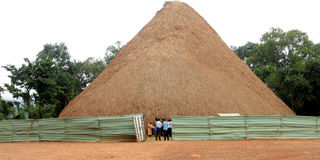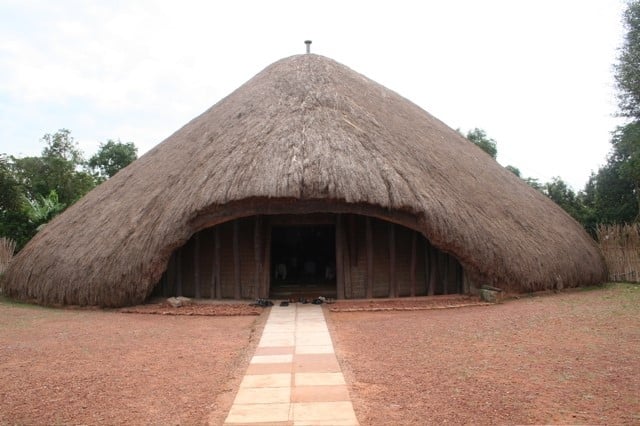Prime
Restoration of Kasubi Royal Tombs takes shape

Muzibu-Azaala-Mpanga, the main house at the Kasubi Royal Tombs site in Kampala, on February 24. Photos/Morgan Mbabazi
What you need to know:
- After the partial destruction of the site by fire in 2010, it was placed on the List of World Heritage in Danger by Unesco.
The Kasubi Reconstruction Committee says the restoration of the Unesco World Heritage Site is at the roofing stage and if all goes according to plan, it will be taken off the List of World Heritage in Danger by the end of the year.
“We commend the project management team and other cultural teams for the work done. The reconstruction has reached the roofing phase, with the first stage already completed,” a member of the committee and minister of tourism and culture in Buganda Kingdom, Mr David Kyewalabye Male, said.
“The interior furnishing and beautification by the Bagirinnya of the Ngo Clan has also started with the main entrance. It is now clearly visible, that our efforts have been put to the intended purpose. We pledge to continue moving in that direction,” Mr Male added.
He added that apart from the support rendered towards the reconstruction and restoration of Muzibu-Azaala-Mpanga, the main house, a number of other accomplishments have been realised through the support of Unesco and the Government of Uganda.
Mr Male pointed out five achievements that include the renovation of Bujjabukula (gatehouse) without altering its original composition in terms of materials used and structure and provision of a temporary fire fighting system comprised of number of sizeable fire extinguishers that can be used in case of any fire emergencies.

Officials from Buganda Kingdom and Unesco Regional Director for Eastern Africa, Prof Hubert Gijzen, tour Kasubi Royal Tombs on February 24.
New facilities
The Buganda culture minister added that the site office has been equipped with Internet connectivity, computers, bookshelves, office chairs and work stations, movable drawers, and cabinets, among others. These are intended for documentation (visual and text) of the reconstruction process, and refinement of the Site Disaster Risk Management Plan that will enhance the heritage conservation aspect of the site in safeguarding its outstanding universal values (OUV), a project that intends to establish model farms for thatching grass, reeds and the Misambya (Markhamia lutea) trees.
Mr Male made the remarks during the visit of the Unesco Regional Director for Eastern Africa, Prof Hubert Gijzen, to Kasubi Royal Tombs on February 24 to check on the progress of the reconstruction of the site.
In attendance at the Kasubi site in Kampala were officials from the Ministry of Tourism, Wildlife, and Antiquities, Uganda National Commission for Unesco, Buganda Kingdom, and Kasubi Reconstruction Committee.
The Kasubi Royal Tombs of Buganda Kings were inscribed on the UNESCO World Heritage List in 2001. After the partial destruction of the site by fire on March 16, 2010, the site was placed on the List of World Heritage in Danger by the World Heritage Committee. This list aims to raise international support for the conservation of world heritage properties. Unesco has, therefore, mobilised the international community to help safeguard and renovate both tangible and intangible aspects of the Kasubi Tombs as a unique cultural monument of Outstanding Universal Value.
On March 1, 2013, Unesco signed the Plan of Operation with the Ugandan government for the project ‘Technical and financial assistance for the reconstruction of Muzibu-Azaala-Mpanga, architectural masterpiece of the Tombs of Buganda Kings at Kasubi, Uganda, World Heritage property in Danger,’ supported through the Japanese Funds-in-Trust.
“The reconstruction of Muzibu-Azaala-Mpanga would have been a very simple task if all we had to do was to put up an architectural masterpiece. However, the intangible cultural intricacies (of belief, spirituality, continuity and identity) required utmost attention to values that make Muzibu-Azaala-Mpanga different from other grass-thatched house. We have ensured maximum respect to those values, and where circumstances demanded, we were compelled to undo and redo some processes,” Mr Male said.

Artisans bind the grass-thatch to be fixed on the roof of Muzibu-Azaala-Mpanga, the main house at the Kasubi Royal Tombs site.
Appeal to government
Mr Male called for immediate instalment of the permanent fire fighting system.
“As we move towards the completion of Muzibu-Azaala-Mpanga, our major threat at the moment is the fire disaster, whose implication in case of any outbreak, would result in ruining all that we have done in the last decade. There is urgent need to expedite the instalment of the permanent firefighting system that was funded by the Japanese government through the ‘Japanese funds-in-Trust,” he said.
“We also need to understand the Muzibu-Azaala-Mpanga, through the main house; it is a section of an entire establishment of the traditional palace of the kings of Buganda. There are a number of houses that surround the main house, each with a particular purpose that it serves in the palace. A number of them are currently roofed with iron sheets which is contrary to the tradition and the spirit of conservation. All of them must be restored to their original grass-thatched status. There is need to restore all royal artifacts that represent particular cultural values and many other components,” Mr Male said.
“We hope this site will be removed from the List of World Heritage in Danger by the end of this year,” he added.
Prof Gijzen congratulated Kasubi Reconstruction Committee for the good job done so far. He said his visit to Buganda was the highlight of his trip in the sub-region. “Visiting such sites is important because they tell a story, enable us to reflect on a history, and they a globe value for all of us,” he said.
“It is sad to see damages to world heritage sites. Being on the endangered list puts you on the spotlight to ensure that the site is restored to the UNESCO World Heritage List. I hope this site will be returned to its original list, but it will require a lot of effort,” Prof Gijzen said.
“The next step should be to turn this facility into a flourishing site,” he added.
READ MORE




